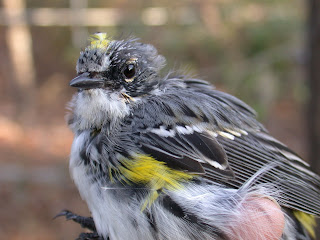


On Saturday the 14th, the first of the season Green Heron appeared at the station. [As three Snowy Egrets had flown past on Friday, this completed the list of herons expected to be seen at First Landing during the breeding season.] The sight of a Green Heron always causes me to reflect on a flightless, still somewhat-downy, juvenile Green Heron which I “boarded” in my bathtub for two weeks in late July a number of years ago in upstate New York.
That heron had walked out of the hayfields and into the front yard on a Sunday morning. It was about to be killed by my farm flock of laying hens. I grabbed the bird before the hens could undertake their plan.
According to the first breeding bird atlas of New York State, Green Herons did not breed in my county. Nor did they breed above 1200 feet in elevation. This heron disproved both hypotheses. The bird wanted no part of wetted dog food. But the juvenile instantly grabbed an offered frog and knew what to do with it. As that Green Heron daily consumed a dozen or more frogs and fished from a large dog bowl as many minnows as I could catch, it allowed a glimpse into what it is to be a wild creature and how proficient they are at it. (The bird never tolerated close human presence. It hissed at every approach.)
On the morning of the bird’s release, a bright band identifying this Green Heron was placed on the right leg. With a cotton hood over the bird’s head to reduce stress, I walked the heron down to the stream which runs through my farm out of which I had taken many of the frogs and minnows. As the time came to release the bird into our world, I found myself trembling and in tears. What would become of “Esmeralda?” Would THIS bird survive a first south-bound migration? Would THIS heron find wintering habitat in which to survive the non-breeding season? Would THIS individual complete a north-bound migration and perhaps even return to this area to breed?
My fears were not about Esmeralda’s fitness to survive in an environment in which Green Herons had evolved for countless generations. Rather, it was whether this bird could survive the obstacles of what we call “our civilization.” I ask that question and wish good fortune for each wild bird I have the privilege to handle. Each year these obstacles rapidly grow in number and degree.
It is now possible for everyone to follow individual wild birds of many species through web cams and satellite positioning devices. [The weight of such devices is now light enough to place such transmitters safely aboard birds weighing as little as 100 grams.] Likely you know about web sites for eagles, falcons and loons. Thanks to a tip from an old friend in New Zealand, you might try following the current north-bound migration of Bar-tailed Godwits, a shorebird related to the Marbled and Hudsonian Godwits seen on the east coast of the United States, from wintering grounds in New Zealand to breeding grounds in Siberia and Alaska at: www.werc.usgs.gov/sattrack/shorebirds/overall.html or www.nzshorebirds.com Read about the destruction of important stop-over sites in Korea.
If you find yourself bound to these remarkable birds do not be surprised for we are each bound to the other; do something. Join an organization, like Coastal Virginia Wildlife Observatory, cvwo.org, or Defenders of Wildlife, defenders.org. Speak out for the conservation and preservation of healthy ecosystems in your community. Ask questions of government, such as why the Cape Hatteras National Seashore allows off-road vehicles year-around use of beach areas essential to the survival and recovery of sea turtles, migrating shorebirds and beach-nesting plovers, terns and oystercatchers.
Peter




































































